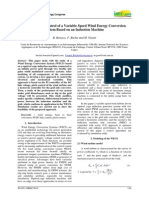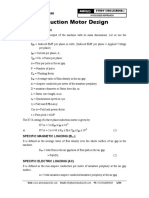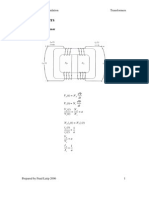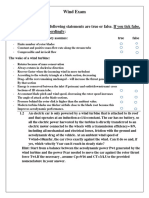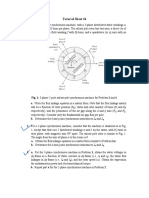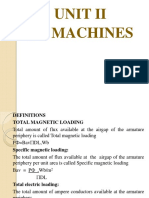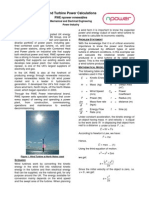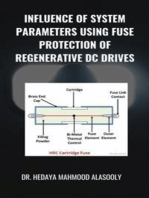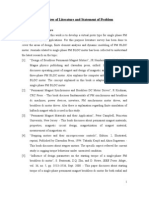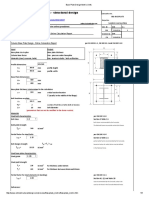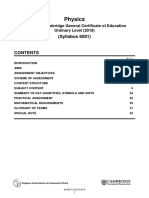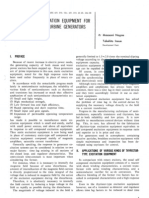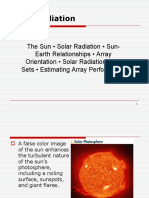Design Rotating Mahcines
Design Rotating Mahcines
Uploaded by
Shilpi GuptaCopyright:
Available Formats
Design Rotating Mahcines
Design Rotating Mahcines
Uploaded by
Shilpi GuptaOriginal Description:
Original Title
Copyright
Available Formats
Share this document
Did you find this document useful?
Is this content inappropriate?
Copyright:
Available Formats
Design Rotating Mahcines
Design Rotating Mahcines
Uploaded by
Shilpi GuptaCopyright:
Available Formats
GENERAL CONCEPTS AND CONSTRAINTS IN DESIGN OF ROTATING MACHINES The purpose of this section is to try to relate the rating
of rotating machines to their main dimensions. Main dimensions: The armature diameter D and armature core length L are known as the main dimensions of a rotating machine. Total Loading Total magnetic loading: The total flux around the armature periphery at the air gap is called the total magnetic loading. Total magnetic loading = p. Total electrical Loading: The total number of ampere conductors around the armature periphery is called the total electric loading. Total electric loading = Iz.Z Specific loading: Two types of loading are specified which are the starting point in the design of rotating electrical machines. 1. Specific magnetic loading: The average flux density over the air gap of a machine is known as specific magnetic loading.
2. Specific electric loading: The number of armature ampere conductors per meter of armature periphery at the air gap is known as specific electric loading.
Output Equation: The output of a machine can be expressed in terms of its main dimensions, specific magnetic and electric loadings and speed; the equation describing this relationship is known as Output Equation. The output equations of the more important machines are given below: 1. DC Machines: power developed by armature in kW Pa = generated emf X armature current X 10-3 = EIa X10-3 But E=Znp/a Pa = Zn(p/a). Ia X10-3 = (p)( IaZ/a)n X10-3 = (p)( IzZ)n X10-3 Hence Pa = total magnetic loading X total electric loading X speed in rps X 10-3 Therefore, basically the output of a d.c. machine is determined by the total loadings. Pa = (specific magnetic loading X DL)(specific electric loading X D)X speed in rps X 10-3 Pa = (Bav X DL)(ac X D)X speed in rps X 10-3 = (2 Bav ac X 10-3)D2Ln = C0D2Ln Where C0= 2 Bav ac X 10-3 The above equation is known as output equation and C0 is defined as the output coefficient. 2. AC machine: consider an m phase machine having one circuit per phase, kA rating of machine
Q = number of phase X output voltage per phase X current per phase X 10-3 = m Eph Iph X 10-3 Terminal voltage of each phases may be taken equal to the induced emf per phase. We have, Induced emf per phase Eph =4.44 f Tph Kw Hence Q = mX 4.44 f Tph Kw Iph X 10-3 But f=pns/2 Therefore we can write Q = mX 4.44 (pns/2) Tph Kw Iph X 10-3 Now current in each conductor Iz = I ph Total number of armature conductors Z= number of phases X ( 2 X turns per phase) = 2 m Tph Hence total electric loading = Iz Z = 2 m Iph Tph hence, Q= 1.11 Kw (total magnetic loading) ( total electric loading) (synchronous speed) x 10-3 Q= 1.11 Kw (specific magnetic loading X DL)(specific electric loading X D) (synchronous speed) x 10-3 Q= (1.11 2Kw Bav ac X 10-3)D2Lns = (11 Kw Bav ac X 10-3)D2Lns = C0 D2Lns Where C0 =11 Kw Bav ac X 10-3, is defined as the output coefficient for an a.c. machine. Factors affecting Size of rotating machine: Examining output equation of the d.c. and a.c. machines it is observed that product D2L will decrease with increase of speed and/or increase of output co-efficient. Thus the volume of active parts of a rotating machine is (/4) D2L and evidently therefore the volume of active parts and hence the size ande the cost of the machine decreases with increase in speed and/or increase in the value of output co-efficient. Hence following factors affects the size of the machine: 1. Speed: it is clear from output equation of the machine that the volume of active parts varies inversely as the speed. Thus for the same output a machine designed with greater speed will have smaller size and hence lesser cost s compared to a machine designed with smaller speed. Therefore whenever a choice has to be made the highest practical speed rating should be selected. However, in special circumstances, the maximum speed may be limited by mechanical stresses in the armature materials. 2. Output coefficient: from the output equation of the machine it is clear that the volume of active parts I inversely proportional to the value of output co-efficient C0. Thus an increase in the value of C0 results in reduction in size and cost of machine and so looking from the economics point of view the value of output co-efficient should be as high as possible. Since the output coefficient is proportional to product of specific magnetic and specific electric loadings we conclude that the size and hence also the cost of machine decreases if increased values of specific magnetic and specific electric loading are used. How much high they should be pushed is decided by the designer by analysuing the effect of increased loadings on performance characteristics of machine as the cost of machine is not the only important aspect of a machine design.
You might also like
- The Design of Everyday ThingsDocument270 pagesThe Design of Everyday ThingsShengGuo95% (56)
- Calculation of Short-Circuit IEC 60909Document6 pagesCalculation of Short-Circuit IEC 60909Iuliu Grad88% (8)
- Synchronous Machine Problems With SolutionsDocument34 pagesSynchronous Machine Problems With Solutionsgsantosh06No ratings yet
- Exp. 3 - Load Test and Equivalent Circuit Determination On Three Phase Squirrel Cage Induction Motor andDocument9 pagesExp. 3 - Load Test and Equivalent Circuit Determination On Three Phase Squirrel Cage Induction Motor andSanjay MeenaNo ratings yet
- Transmission Fault CodesDocument9 pagesTransmission Fault CodesDragan LugonićNo ratings yet
- Assignment 5Document5 pagesAssignment 5maha saeedNo ratings yet
- Paper ID 105Document6 pagesPaper ID 105hassenbbNo ratings yet
- Free-Samples Amie Chapters Induction-Motor-DesignDocument35 pagesFree-Samples Amie Chapters Induction-Motor-DesignGlen TuranganNo ratings yet
- Induction Motor DesignDocument35 pagesInduction Motor DesignGajendra Teli100% (1)
- Induction Motor DesignDocument34 pagesInduction Motor DesignNasr GhanmiNo ratings yet
- 11 Synchronous Generator and Motor OperationDocument29 pages11 Synchronous Generator and Motor OperationkkrishnamoorthyNo ratings yet
- DTrends Feb 2011Document14 pagesDTrends Feb 2011Rui AllenNo ratings yet
- Power Maximization Control of Small Wind System Using Permanent Magnet Synchronous GeneratorDocument13 pagesPower Maximization Control of Small Wind System Using Permanent Magnet Synchronous GeneratorhassenbbNo ratings yet
- Fault Level - ProcedureDocument8 pagesFault Level - ProcedureAmrut ShishirNo ratings yet
- Supervised Learning Based Algorithm For Optimal Design of IM To Improve EfficiencyDocument6 pagesSupervised Learning Based Algorithm For Optimal Design of IM To Improve EfficiencyAli Arslan SafdarNo ratings yet
- Estimacion CPDocument6 pagesEstimacion CPEdjavier CastilloNo ratings yet
- IEC Short Circuit CalculationDocument16 pagesIEC Short Circuit CalculationJoselito Vaca50% (2)
- 5 6307600313914232250Document30 pages5 6307600313914232250Samsung TabletNo ratings yet
- Semester I Examinations - 2011/2012Document7 pagesSemester I Examinations - 2011/2012Ismail HussainNo ratings yet
- 3.0 Transformers: 3.1 The Ideal TransformerDocument16 pages3.0 Transformers: 3.1 The Ideal Transformerhafiz_jaaffarNo ratings yet
- SMMA Motor GlossaryDocument11 pagesSMMA Motor GlossaryNurulHardyNo ratings yet
- Laboratory Induction MotorsDocument17 pagesLaboratory Induction MotorsEsteban GilNo ratings yet
- 3 Phase Slip Ring Inductionmotor LoadtestDocument9 pages3 Phase Slip Ring Inductionmotor LoadtestBhatia AdvancedNo ratings yet
- Web Motor GlossaryDocument7 pagesWeb Motor GlossaryansabhiNo ratings yet
- Impact of The Design Method of Permanent Magnets Synchronous Generators For Small Direct Drive Wind Turbines For Battery OperationDocument5 pagesImpact of The Design Method of Permanent Magnets Synchronous Generators For Small Direct Drive Wind Turbines For Battery OperationhassenbbNo ratings yet
- Modeling and Simulation of PMSG Based Wecs: Jamuna V Baskar M Senthoorselvam DDocument5 pagesModeling and Simulation of PMSG Based Wecs: Jamuna V Baskar M Senthoorselvam DSundaraPandiyanNo ratings yet
- A Comparison of Torque Capabilities of Axial Flux and Radial Flux Type of Brushless DC BLDC Drives For Wide Speed Range ApplicationsDocument6 pagesA Comparison of Torque Capabilities of Axial Flux and Radial Flux Type of Brushless DC BLDC Drives For Wide Speed Range ApplicationssosiNo ratings yet
- Catalogue Sisvar en V4Document82 pagesCatalogue Sisvar en V4Saša MiloševićNo ratings yet
- MAXON BLDC As GeneratorsDocument14 pagesMAXON BLDC As GeneratorsRadu BabauNo ratings yet
- Thermal Modeling and On-Line MornitoringDocument14 pagesThermal Modeling and On-Line MornitoringThi Phuong Thanh LeNo ratings yet
- International Refereed Journal of Engineering and Science (IRJES)Document8 pagesInternational Refereed Journal of Engineering and Science (IRJES)www.irjes.comNo ratings yet
- Wind ExamDocument8 pagesWind Examwaltikra100% (1)
- U6 L42 - Blondel'sTwo Reaction TheoryDocument7 pagesU6 L42 - Blondel'sTwo Reaction Theorykjel reida jøssanNo ratings yet
- Lab Manual Load - Test - On - DC - Shunt - Motor PDFDocument8 pagesLab Manual Load - Test - On - DC - Shunt - Motor PDFfongNo ratings yet
- Schneider - Power Factor Correction and Harmonic Filtering (B - 954 - 503 - 439)Document82 pagesSchneider - Power Factor Correction and Harmonic Filtering (B - 954 - 503 - 439)Ieremeiov Vladimir100% (1)
- Induction Motor Notes LVBDocument14 pagesInduction Motor Notes LVBlvb123No ratings yet
- I JX I JX R I V E: C D C DDocument119 pagesI JX I JX R I V E: C D C DCharlton ChristNo ratings yet
- ESPsDocument10 pagesESPs_andhikasaputraNo ratings yet
- Synchronous Machine DesignDocument35 pagesSynchronous Machine DesignvietnhuNo ratings yet
- Design and Analysis of 42-V Permanent-Magnet Generator For Automotive ApplicationsDocument12 pagesDesign and Analysis of 42-V Permanent-Magnet Generator For Automotive ApplicationsNicholas ValdezNo ratings yet
- Synchronous Motor Test TestDocument5 pagesSynchronous Motor Test TestChidamparam PalaniyappanNo ratings yet
- Questions For The Electrical MachinesDocument3 pagesQuestions For The Electrical MachinesYaman SahuNo ratings yet
- DC-DC Converter For Charging and Discharging Super-Capacitors Used in Electric Hybrid CarsDocument8 pagesDC-DC Converter For Charging and Discharging Super-Capacitors Used in Electric Hybrid CarsTung DaoNo ratings yet
- Swinburne Test: Loss Summation Method in DC Shunt MachinesDocument8 pagesSwinburne Test: Loss Summation Method in DC Shunt MachinesDilip TheLipNo ratings yet
- CS7Document8 pagesCS7zubairashrafNo ratings yet
- A Comparison of Power Density For Axial Flux Machines Based On General Purpose Sizing EquationsDocument8 pagesA Comparison of Power Density For Axial Flux Machines Based On General Purpose Sizing EquationsMostafa AhmadiNo ratings yet
- Tutorial Sheet 04Document5 pagesTutorial Sheet 04Abhishek ThakurNo ratings yet
- Load FlowDocument26 pagesLoad Flowsurya892No ratings yet
- 5 Interconnected Synchronous Generators: 5.1 Load SharingDocument17 pages5 Interconnected Synchronous Generators: 5.1 Load SharingNishant KumarNo ratings yet
- School of Electrical, Electronic and Communications EngineeringDocument7 pagesSchool of Electrical, Electronic and Communications EngineeringIsmail HussainNo ratings yet
- Transient StabilityDocument16 pagesTransient StabilityRavi Kumar BanalaNo ratings yet
- L-13 (DK) (Pe) ( (Ee) Nptel)Document108 pagesL-13 (DK) (Pe) ( (Ee) Nptel)Akshaya HariharanNo ratings yet
- Experiment 7 ET 332b No-Load and Starting Characteristics of Squirrel-Cage Induction Motors PurposeDocument12 pagesExperiment 7 ET 332b No-Load and Starting Characteristics of Squirrel-Cage Induction Motors PurposeGopinath B L NaiduNo ratings yet
- Simulation and Analysis of PMSG-based Wind Energy Conversion System Using Different Coverter ModelsDocument5 pagesSimulation and Analysis of PMSG-based Wind Energy Conversion System Using Different Coverter ModelsHamza MahmoodNo ratings yet
- Wind Turbine Power CalculationDocument5 pagesWind Turbine Power CalculationRavi Acharya100% (3)
- 23 Wind TurbineDocument5 pages23 Wind TurbineErtuğrul ÖzelNo ratings yet
- Reference Guide To Useful Electronic Circuits And Circuit Design Techniques - Part 1From EverandReference Guide To Useful Electronic Circuits And Circuit Design Techniques - Part 1Rating: 2.5 out of 5 stars2.5/5 (3)
- Influence of System Parameters Using Fuse Protection of Regenerative DC DrivesFrom EverandInfluence of System Parameters Using Fuse Protection of Regenerative DC DrivesNo ratings yet
- Reference Guide To Useful Electronic Circuits And Circuit Design Techniques - Part 2From EverandReference Guide To Useful Electronic Circuits And Circuit Design Techniques - Part 2No ratings yet
- Aluminium and Its Alloys Used in Electrical EngineeringDocument7 pagesAluminium and Its Alloys Used in Electrical EngineeringTigrilloNo ratings yet
- Feaa PortionDocument130 pagesFeaa Portion20951a2167No ratings yet
- Grade 12 Mathematics Inverse Functions SolutionsDocument20 pagesGrade 12 Mathematics Inverse Functions SolutionsHitekani Imargine100% (1)
- Im ch01Document11 pagesIm ch01Stefan SvärdNo ratings yet
- 2.review of Literature and Statement of ProblemDocument6 pages2.review of Literature and Statement of ProblemsheriabhiNo ratings yet
- Suspension Cable Bridge SystemDocument4 pagesSuspension Cable Bridge SystemNur Syahira0% (4)
- Home Work/Project Work/Assignment For Summer Vacation 2018Document8 pagesHome Work/Project Work/Assignment For Summer Vacation 2018Sahil KhuranaNo ratings yet
- Differential Equations DissertationDocument7 pagesDifferential Equations DissertationDoMyCollegePaperUK100% (2)
- Transformer MaintenanceDocument60 pagesTransformer MaintenanceMidhun Varghese100% (2)
- Solomon L QP - S1 EdexcelDocument4 pagesSolomon L QP - S1 EdexcelabhayNo ratings yet
- KCT 2018Document134 pagesKCT 2018Naveenprabhu VNo ratings yet
- PFA Plain SheetDocument1 pagePFA Plain SheetmansurudinNo ratings yet
- Moore Fan 02Document7 pagesMoore Fan 02vikramNo ratings yet
- Base Plate Design Metric UnitsDocument5 pagesBase Plate Design Metric UnitsD SRINIVAS100% (1)
- Queuing and Reliability Theory (MATH712) : MODULE 2: Advanced Queuing ModelsDocument14 pagesQueuing and Reliability Theory (MATH712) : MODULE 2: Advanced Queuing ModelsAnisha GargNo ratings yet
- 6091 - 2018 O Level Phy First Exam 2018Document32 pages6091 - 2018 O Level Phy First Exam 2018raist_angNo ratings yet
- OM-E-CL500 Rev.4 - Operator's Manual English HTI CL-500Document28 pagesOM-E-CL500 Rev.4 - Operator's Manual English HTI CL-500Trần Thanh ViệnNo ratings yet
- Fuji Generators FER-14-01-01-1968Document7 pagesFuji Generators FER-14-01-01-1968alan.edwards7282No ratings yet
- Chem Lava LampDocument13 pagesChem Lava Lampapi-353843842No ratings yet
- Summative Test 2nd QuarterDocument2 pagesSummative Test 2nd QuarterPortgas D. AceNo ratings yet
- Unit II Lecture-1-SolarRadiationDocument35 pagesUnit II Lecture-1-SolarRadiationSelvaraj SathiyaseelanNo ratings yet
- Dse810 ManualDocument132 pagesDse810 ManualCleto Delacruz Lopez100% (1)
- 4a - CRITICAL STATE OF SOIL MECHANICS Light BKGRD Black Fonts-27092020Document59 pages4a - CRITICAL STATE OF SOIL MECHANICS Light BKGRD Black Fonts-27092020rihongkeeNo ratings yet
- Physics Fast Revision NotesDocument8 pagesPhysics Fast Revision NotesdivyanshagrawalbsNo ratings yet
- Application Note: Sentry Spiral Tube Heat Exchanger Vent Condenser ApplicationDocument2 pagesApplication Note: Sentry Spiral Tube Heat Exchanger Vent Condenser ApplicationraritylimNo ratings yet
- CHEM 1305 Introductory Chemistry - 1-11-17Document367 pagesCHEM 1305 Introductory Chemistry - 1-11-17Arima Kousei100% (1)
- CHEMKIN TutorialDocument15 pagesCHEMKIN TutorialOsas E EghoNo ratings yet
- Guia de PesticidasDocument158 pagesGuia de PesticidasFabian EspinelNo ratings yet






